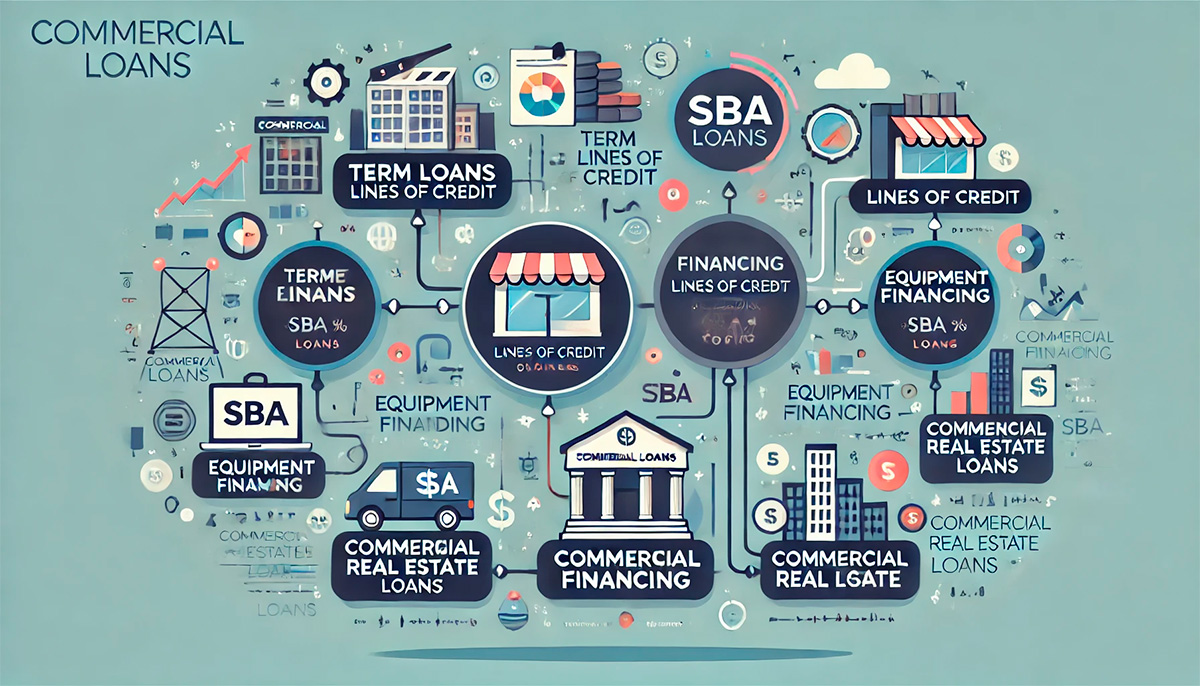
Understanding Commercial Loans: A Comprehensive Guide for Business Owners
Commercial loans are a vital financial tool for business owners, enabling them to start, grow, and sustain their enterprises. Whether funding expansion, purchasing equipment, or managing cash flow, commercial loans provide the necessary capital to achieve business goals. However, understanding the nuances of these loans is essential for making informed decisions and ensuring long-term success.
This guide explores the fundamentals of commercial loans, their types, benefits, and how business owners can effectively leverage them to enhance their operations.
What Are Commercial Loans?
Commercial loans are financing products designed specifically for businesses. Unlike personal loans, these loans are tailored to meet the unique needs of companies, offering larger amounts, flexible terms, and repayment structures suited to commercial objectives. They are typically used for purposes such as acquiring real estate, purchasing equipment, funding operational expenses, or investing in new opportunities.
Lenders evaluate several factors when approving a commercial loan, including the business’s financial health, credit history, revenue, and the purpose of the loan. These loans can be secured, requiring collateral such as property or equipment, or unsecured, relying solely on the business’s creditworthiness.

Types of Commercial Loans
Business owners have access to various types of commercial loans, each designed to address specific financial needs. Understanding these options helps in selecting the most suitable solution.
Term Loans
Term loans are among the most common commercial loans. They provide a lump sum upfront, which is repaid over a fixed term with interest. These loans are ideal for significant investments, such as purchasing equipment or expanding facilities.
Lines of Credit
A line of credit offers flexible access to funds, allowing businesses to borrow as needed up to a predetermined limit. This option is particularly useful for managing cash flow, covering unexpected expenses, or handling seasonal fluctuations in revenue.
SBA Loans
Small Business Administration (SBA) loans are government-backed loans that support small businesses. Programs like the SBA 7(a) and 504 loans offer favorable terms, such as lower interest rates and longer repayment periods, making them a popular choice for startups and small enterprises.
Equipment Financing
Designed specifically for purchasing machinery, vehicles, or other essential tools, equipment financing uses the purchased equipment as collateral. This reduces the risk for lenders and often results in favorable terms for borrowers.
Commercial Real Estate Loans
These loans are tailored for purchasing or renovating commercial properties, such as office buildings, warehouses, or retail spaces. They typically require a substantial down payment and are repaid over long terms.
Bridge Loans
Bridge loans provide short-term financing to cover immediate needs, such as purchasing property or addressing cash flow gaps while awaiting long-term funding. Although they often have higher interest rates, they offer quick access to capital.
Benefits of Commercial Loans
Commercial loans offer numerous advantages, making them an essential resource for business owners.
One of the primary benefits is access to capital, which enables businesses to pursue growth opportunities without draining cash reserves. Whether investing in new technology, hiring additional staff, or expanding into new markets, loans provide the financial flexibility to achieve these goals.
Another advantage is the ability to manage cash flow effectively. By covering operational expenses during slow periods or funding inventory purchases ahead of peak seasons, commercial loans help maintain financial stability.
Additionally, many commercial loans come with tax benefits. Interest paid on these loans is often tax-deductible, reducing the overall cost of borrowing and enhancing profitability.
How to Qualify for a Commercial Loan
Qualifying for a commercial loan requires thorough preparation and a clear understanding of the lender’s requirements. Business owners can increase their chances of approval by focusing on several key areas.
Financial Documentation
Lenders typically request detailed financial statements, including balance sheets, profit and loss statements, and cash flow reports. These documents demonstrate the business’s financial health and its ability to repay the loan.
Creditworthiness
A strong credit history, both for the business and the owner, is crucial for securing favorable loan terms. Lenders assess credit scores to gauge reliability and risk.
Clear Business Plan
A well-prepared business plan outlining the loan’s purpose, expected outcomes, and repayment strategy is essential. This demonstrates the business’s commitment to success and helps build lender confidence.
Collateral
For secured loans, providing collateral can increase approval chances and result in better terms. Common collateral includes real estate, equipment, or inventory.
Choosing the Right Lender
Selecting the right lender is as important as choosing the right loan. Different lenders cater to various business needs and offer unique advantages.
Traditional banks are a reliable choice for businesses with strong credit profiles, offering competitive rates and personalized service. However, their application processes can be lengthy and require extensive documentation.
Credit unions often provide lower interest rates and more flexible terms, making them an excellent option for small businesses. Their member-focused approach ensures a supportive lending experience.
Online lenders prioritize convenience and speed, offering quick approvals and a streamlined application process. They are particularly useful for businesses needing fast funding or those with less-than-perfect credit.

Managing Commercial Loans Effectively
Once a commercial loan is secured, managing it responsibly is crucial to ensuring its benefits outweigh the costs.
Budgeting for Repayments
Incorporate loan repayments into your business budget, ensuring consistent cash flow to meet obligations. Automating payments can help avoid missed deadlines and penalties.
Allocating Funds Strategically
Use the loan for high-impact investments that directly contribute to growth or profitability. Avoid using funds for non-essential expenses that don’t yield measurable returns.
Monitoring Financial Performance
Regularly review your business’s financial performance to ensure that the loan is delivering the intended results. Adjust your strategy if necessary to maximize the loan’s impact.
Risks and Considerations
While commercial loans offer significant benefits, they also come with risks that require careful consideration. Borrowing beyond the business’s repayment capacity can lead to financial strain or even default. It’s essential to evaluate the loan’s affordability and ensure the terms align with your business’s revenue projections.
Interest rates and fees can also add to the cost of borrowing. Comparing multiple lenders and understanding all associated costs is crucial to securing the best deal.
Conclusion: Leveraging Commercial Loans for Success
Commercial loans are a cornerstone of modern business, providing the capital needed to achieve ambitious goals and maintain financial stability. By understanding their options, benefits, and requirements, business owners can make informed decisions that support their objectives.
Whether you’re launching a new venture, expanding operations, or navigating financial challenges, a well-structured commercial loan can be a powerful tool for growth. With careful planning, responsible management, and a clear vision, businesses can leverage loans to unlock new opportunities and achieve long-term success.
